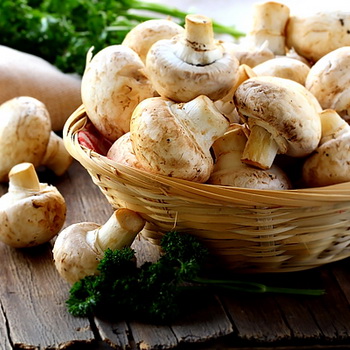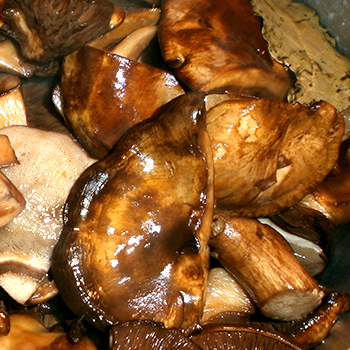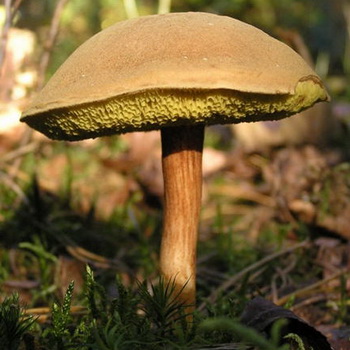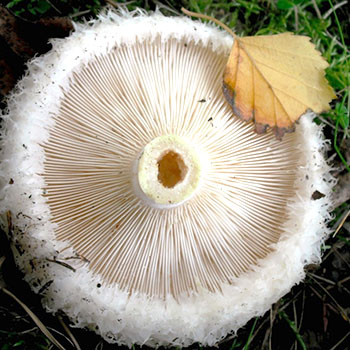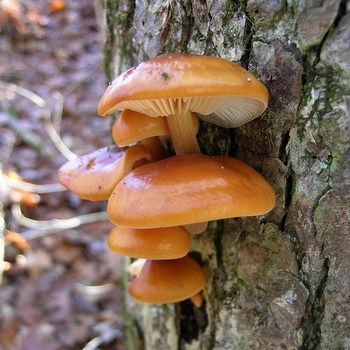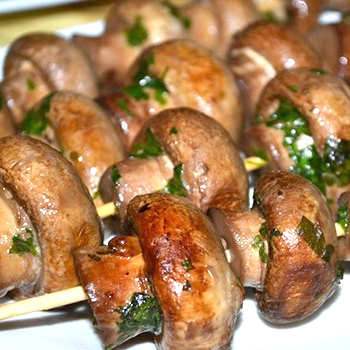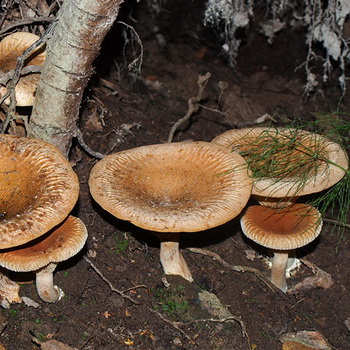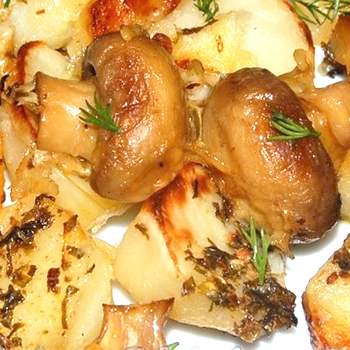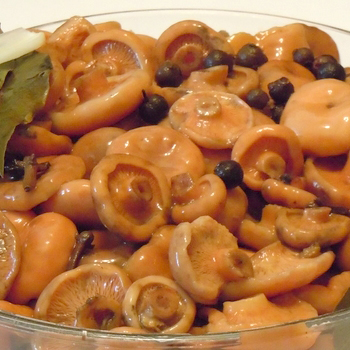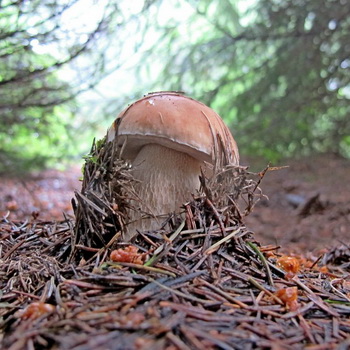How to distinguish a false forest champignon from a real one: a photo and description of poisonous doubles
 Poisonous mushrooms are called "false" mushrooms, which outwardly are very similar to edible counterparts. Dangerous "doubles" are sometimes difficult to distinguish even for experienced mushroom pickers.
Poisonous mushrooms are called "false" mushrooms, which outwardly are very similar to edible counterparts. Dangerous "doubles" are sometimes difficult to distinguish even for experienced mushroom pickers.
Common champignon has many types, and most of them are eaten. It is very difficult to remember the features of each, therefore, lovers of "quiet hunting" are often guided by common signs. This can provoke poisoning: among the Agaricaceae (Champignon) family there are species that are harmful to human health.
Industrial cultivation allows you to enjoy the taste of the product without harm to health, but the number of poisoning with false mushrooms, which are "disguised" as edible specimens, does not decrease. People are attracted by the "quiet hunt" and the opportunity to save money on the purchase of mushrooms. In addition, each individual species has its own flavor: it cannot be found in a standard product from store shelves.
What false champignons look like: photo and description of the appearance of mushrooms


Most often, such representatives of the Agaric family are taken for edible specimens:
- Agaricus xanthodermus.
- Agaricus meleagris.
- Agaricus californicus.
Typical examples of false champignons are shown in the photo.




A number of features will help to distinguish such specimens from edible ones. On the cap, the poisonous twin has a speck of brown color, which is located in the center. If you press on it, light yellow spots will appear. But this method is not guaranteed, so it is better to use it in tandem with other traits.
When broken, the pulp of false forest and field mushrooms begins to turn yellow and smells unpleasant with carbolic acid, and during cooking, the water and the mushrooms themselves turn bright yellow for a short time, but this color quickly disappears. Long-term heat treatment will not be able to rid the product of toxins.
Take a look at the photo and study the description of the appearance of false forest mushrooms.




The color of the cap and its shape can change under the influence of the environment, therefore, special attention is paid to the pulp, its smell, shade and changes during cooking.
Another mushroom that disguises itself as an edible is a pale toadstool. Outwardly, it resembles a champignon, while it does not have a smell by which it could be recognized. There are volves (root sacs) at the base of the toadstool, but people don't always notice them. If you have the slightest doubt about the suitability of the mushroom, you should break the pulp and see if it turns yellow, and then check the color change of the water during cooking. This is one of the most accurate and proven ways to distinguish real edible mushrooms from false ones.
You can only confuse the "young" pale toadstool: over time, bulges will appear on its hat, it will become smooth, and the fringe will become saggy. Toadstool appears from the first half of June, its growth peak falls in August. The height of the toadstool can reach 20-25 cm, and the diameter of the cap does not exceed 15 cm.
Inexperienced mushroom pickers can mistake one of the light amanitas for good mushrooms. In this case, the unpleasant smell that the pulp has will save from poisoning.
If you don't know what poisonous false mushrooms look like, take a look at the photo: these are common mushrooms that are often mistaken for edible ones.




Real champignons: distribution places and distinctive features
To understand how to distinguish edible champignon from false champignon, you need to know their distinctive features, the places where they are common and the time of their growth.
"Correct" mushrooms can be found in shady flower beds, along roadsides, in flower beds. There usually grows two-pore (Agaricus bisporus) and two-ring (Agaricus bitorquis) champignon. For garden varieties, light shades are characteristic - from white to grayish and light cream.The cap of a two-ring mushroom opens even in the upper layer of the soil, so the color can be influenced by the leaves or humus covering it.
Common (Agaricus campestris) and large-spore (Agaricus macrosporus) species of fungus can be found in the steppe, in fields and meadows. Poisonous representatives of the Agaric family are rarely found here.
In plantings near trees, a field species (Agaricus arvensis) grows, which is harvested from mid-May to late September.
Compare the photo of the real and the image of the false champignon: the difference is not always visible.




Forest moisture and shade are excellent conditions for the development of species such as coppice, dark red, forest and August champignon. They appear in early July and grow until October. Their peculiarity is that after cutting, young mushrooms appear in the same place after 10-15 days.
But the most common forest false mushrooms are found in the forest - look at the photo, how they look.




Inedible twins grow away from direct sunlight: light-colored amanita can be found under spruce or birch trees, and pale grebe is unpretentious in choosing deciduous trees.
But poisonous specimens can be found even in places of growth that are uncharacteristic for this species, so you need to be extremely careful.
False mushroom food poisoning
Even proven mushrooms can cause poisoning if they are harvested in the wrong place. These are the sides of large roads, areas near industrial facilities, landfills. Mushrooms, like a sponge, absorb toxic substances, including carcinogens.
Having studied the description of the places where the false forest mushroom grows, look at the photo of this specimen in natural conditions.




It is almost impossible to determine the presence of toxins in it at home.
Another nuance to remember: these mushrooms are dangerous to pickle and roll up for the winter. If they are undercooked, undersalted, or rolled up in a leaky can, botulinus bacteria will begin to develop inside the product. They cause severe food poisoning that can lead to further health problems. In the factory, mushrooms undergo heat treatment, which destroys pathogenic bacteria.
It is not worth mentioning that one toxic champignon can turn all preservation into a poisonous product.
In order to find a dangerous "neighbor" in time, having studied the descriptions given earlier, take another look at the photos of false mushrooms that resemble champignons.




Multiple cases of poisoning with serious consequences do not stop those who like "quiet hunting".
Most of them surpass in severity the usual toxicoinfections. Children and people with weakened health are especially acutely tolerated by the ingress of poisonous substances into the blood.
The degree of poisoning with cooked false champignon depends on which mushrooms have skillfully "disguised" themselves as it. If it is yellow-skinned, variegated, Californian species or white fly agaric, symptoms may appear within a couple of hours. Nausea and stomach pains are the reason for immediate medical attention.
It is much more difficult to define pale toadstool poisoning. The malaise does not appear earlier than after 8 hours, and sometimes - in 1-2 days after eating it.

